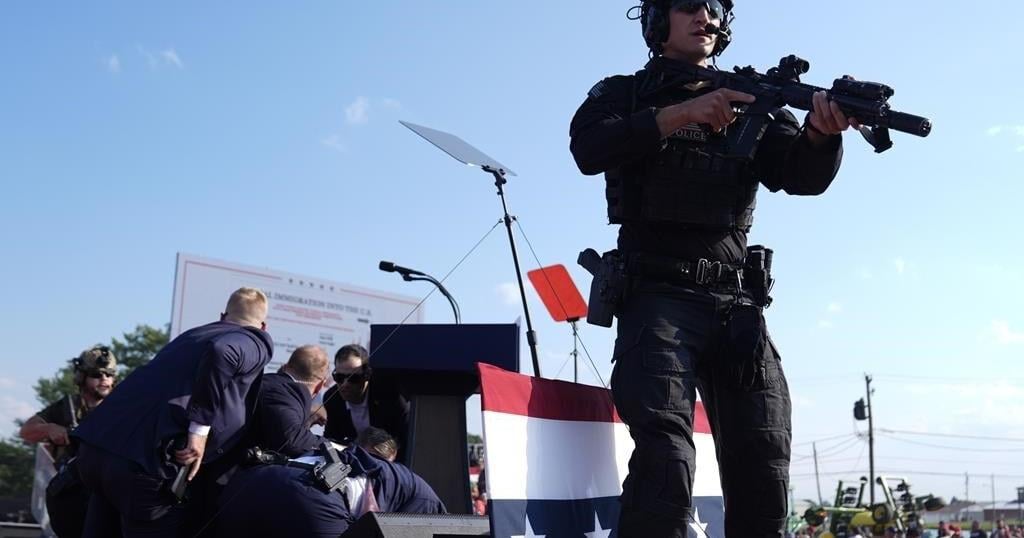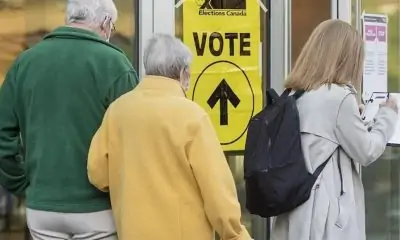VANCOUVER – Voters in British Columbia have been braving torrential rain and high winds across much of the province to take part in an election where they face a choice that would have been unthinkable just a few months ago.
The B.C. Conservatives, whose party won less than two per cent of the vote last election, stand on the brink of forming government or, at least, becoming the official Opposition, with Leader John Rustad challenging New Democrat incumbent David Eby to be premier.
Rustad’s unlikely rise came after he was thrown out of the Opposition, then known as the BC Liberals, joined the Conservatives as leader, and steered them to a level of popularity that led to the collapse of his old party, now called BC United — all in just two years.
Rustad shared a photo on social media Saturday morning showing himself smiling and walking with his wife at a voting station, with a message saying, “This is the first time Kim and I have voted for the Conservative Party of BC!”
Mike McDonald, co-host of the Hotel Pacifico podcast on B.C. politics and a former chief of staff for former premier Christy Clark, said he was expecting a “very close, nail-biter” election.
“We saw that in 2017, where the fate of British Columbia’s government was decided on one seat in the Comox Valley that was won by (the NDP by) 189 votes,” he said.
“The real message here for British Columbians is, if you want to see a particular outcome in this election, you’ve got to get out … and vote.”
More than a million already had, even before polls opened. The advance voting record was smashed, with more than 28 per cent of all registered electors voting early, potentially putting the province on track for a big final turnout.
But an atmospheric river weather system drenched the south and central coasts on Saturday, and Elections BC said the rain had hampered voting at several locations hit by power outages.
Sites in Kamloops, Langley and Port Moody, as well as on Hornby, Denman and Mayne islands, were temporarily closed due to power outages, with election officials redirecting the public to other locations.
All had reopened by mid-afternoon, Elections BC said.
The BC Hydro outage map showed several thousand customers were without power in the Lower Mainland and on the Sunshine Coast Saturday afternoon, along with about 500 on Vancouver Island, down from higher numbers earlier in the day.
Karin Kirkpatrick, who is running for re-election as an independent in West Vancouver-Capilano, said in a statement that her campaign had been in touch with Elections BC about the risk of weather-related disruptions, and was informed that voting tabulation machines have battery power for four hours in the event of an outage.
The atmospheric river drenching B.C.’s coastal regions is forecast to bring up to 150 millimetres of rain to Metro Vancouver, the Fraser Valley, the Sea to Sky corridor and the west coast of Vancouver Island this weekend.
B.C.’s River Forecast Centre issued a flood warning for the Coquitlam River as well as waterways on western Vancouver Island, while lower-level flood watches span the south and central coasts, including the Lower Fraser River and its tributaries.
McDonald said the inclement weather in some of the province’s largest population centres may play a role if the race between the NDP and Conservatives is as close as polls indicate.
“So that would favour the voter base that’s more resolved, that’s more committed, more motivated to turn out to the polls,” McDonald said.
He said there had never been a B.C. election where more than two million people voted, a milestone that could be breached this year.
“That can be a good sign for the opposition (Conservatives), but we also have to look at the fact that people are turning out because they don’t want the Conservatives,” he said. “It’s a much more polarizing election this time, and that may be inducing NDP voters to get out as well.”
It has been a strikingly negative campaign.
Eby, who has depicted Rustad and some of his candidates as extremists and conspiracy theorists, said Friday that he had “left nothing on the table,” and had “no regrets about the campaign.”
Rustad, who did not make himself available to reporters in the final days of the campaign, has called Eby a serial liar.
“The 2024 B.C. election mirrors the same nasty polarization seen in the U.S. presidential campaign, with the B.C. NDP spending most of its time attacking Conservative candidates over indefensible racist and sexist remarks,” said Jeanette Ashe, a political science faculty member at Douglas College. “This left little room for the B.C. NDP to address the real issues BCers care about, like affordable housing and health care.”
But on several fronts, the NDP and the Conservative platforms have overlapped.
Both are pledging tax breaks, with Eby promising a cut worth $1,000 for most households and the Conservatives promising the “Rustad Rebate,” which would eventually make up to $3,000 a month in rent or mortgage payments tax deductible.
Eby says he’ll scrap the provincial carbon tax if the federal government drops its requirement for the tax, and will instead shift the burden to “big polluters,” while Rustad says he’ll scrap the carbon tax completely.
And both parties say they support a greater emphasis on involuntary care to deal with the province’s overlapping crises of homelessness, mental health and addictions.
Green Party Leader Sonia Furstenau has said there is little to separate the two main election contenders, citing involuntary care and their stances on the fossil fuel industry.
Her party, which is hoping to retain a presence in the legislature where it currently has two members, is promising a “windfall profits tax” on oil and gas companies, as well as investment in infrastructure and climate action.
On one matter, all three parties converge: their platforms would result in big first-year increases to the deficit, pushing it to about $9.6 billion under the NDP and Green plans, and near $11 billion under the Conservatives.
Regardless of the election outcome, it has been a stunning rise for B.C. Conservatives and Rustad, brought about in large part by the Shakespearean fall of Official Opposition Leader Kevin Falcon of BC United, who pushed the self-destruct button on his own party less than two months ago.
Falcon had thrown Rustad out of the party in 2022 over his online backing for a climate-change skeptic. But it was Falcon who paid the price.
BC United support cratered following a disastrous name change from the BC Liberals that Falcon had championed, and in late August Falcon stood beside Rustad and ended United’s campaign in order to avoid vote splitting.
That triggered fury from some United legislators who went on to run as Independents, either snubbed or unwilling to join the B.C. Conservatives. If they win, those Independents could hold the balance of power if the election is close.
Ultimately, McDonald said the 2024 B.C. election would be remembered for the “shakeup” of the province’s right-leaning political landscape.
This report by The Canadian Press was first published Oct. 19, 2024.























